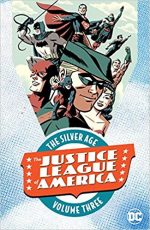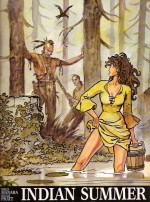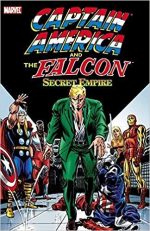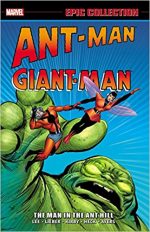
By Dan Abnett, Paul Cornell, Warwick Gray, Richard Alan, John Ridgway, Lee Sullivan, Colin Andrew & various (Panini Books)
ISBN: 978-1-84653-807-0
The British love comic strips and they love celebrity and they love “Characters.â€
The history of our graphic narrative has a peculiarly disproportionate amount of radio comedians, Variety stars and film and television actors such as Charlie Chaplin, Flanagan & Allen, Shirley Eaton (“The Modern Missâ€), Arthur Askey, Winifred Atwell, Max Bygraves, Jimmy Edwards, Charlie Drake and their ilk as well as actual shows and properties such as Whacko!, ITMA, Our Gang (a British version of the Hal Roach film sensation by Dudley Watkins ran in The Dandy as well as the American comicbook series by Walt Kelly), Old Mother Riley, Supercar, Pinky and Perky and literally hundreds more.
Anthology comics such as Radio Fun, Film Fun, TV Fun, Look-In, TV Tornado, TV Comic and Countdown among others all translated our viewing and listening favourites into pictorial joy every week, and it was a pretty poor star or show that couldn’t parley their day job into a licensed comic property.
Doctor Who premiered on black and white televisions across Britain with the first episode of ‘An Unearthly Child’ on November 23rd 1963, and in 1964 his decades-long association with TV Comic began in #674 and the premier instalment of ‘The Klepton Parasites’.
On 11th October 1979 (although adhering to the US off-sale cover-dating system so it says 17th) Marvel’s UK subsidiary launched Doctor Who Weekly, which became a monthly magazine in September 1980 (#44) and has been with us – under various names – ever since. All of which only goes to prove that the Time Lord is a comic hero with an impressive pedigree.
Panini’s UK division is in the ongoing process of collecting every strip from its archive in a uniform series of over-sized graphic albums, each concentrating on a particular incarnation (those in the know refer to them as “regenerationsâ€) of the deathless wanderer. This particular tome reprints tales plucked from the annals of history and the Terran recording dates November 1992 and July 1995.
These yarns all feature the Seventh Doctor (Sylvester McCoy – my second favourite after Patrick Troughton – but I’m sure I’ll be advised why that’s so very wrong by somebody in due course…)
This collection features both monochrome and full-colour episodes and kicks off with sinister espionage thriller ‘Pureblood’ (originally seen in Doctor Who Magazine #193-196: November 1992 to January 1993) by writer Dan Abnett and artist Colin Andrew. Here the devious Time Lord and his formidable companion Benny save the last survivors of the Sontarran race from extinction at the hands of their immortal enemies the Rutan – despite hostage humans and a spy in the embattled clone-warriors’ midst. Why save a deadly enemy? Ah well, The Doctor has a rather convoluted plan…
The epic yarn leads directly into the moody ‘Flashback’ (Doctor Who Winter Special 1992, by Warwick Gray and the superb John Ridgway) as we get a glimpse of the First Doctor (William Hartnell, keep up, keep up!) having a potentially universe- shattering falling out with his best friend: a proudly arrogant young Gallifreyan called Magnus (any guesses who he eventually regenerated as?)
The main meat of this massive collection is the eponymous ‘Emperor of the Daleks’ (Doctor Who Magazine #197-202) which reunites the dashing time meddler with his deadliest foe and their deadliest foe: Abslom Daak, a deranged maniac in love with a dead woman and determined to die gloriously exterminating Daleks…
Written by Paul Cornell and John Freeman with art from Lee Sullivan (and one chapter in full-colour thanks to the talents of Marina Graham), the sprawling epic reveals a civil war between the murderous pepperpots’ creator Davros and their current supreme commander, with the Doctor (two of them, in fact) and a motley crew of allies stirring the bubbling mix and nudging the feuding megalomaniacs in a certain direction…
And when the dust settles Richard Alan and Sullivan provide a salutary epilogue in ‘Up Above the Gods’ (Doctor Who Magazine #227, July 1995) as The Doctor explains his actions to Davros… or so, at least, the deluded devil believes…
Warwick Gray & Colin Andrew then introduce a universe where The Doctor perished in his Third Regeneration leading to a cross dimensional incursion by ours, as well as Benny and Ace, to foil the ‘Final Genesis’ of Silurian/Sea Devil renegade Mortakk (from Doctor Who Magazine #203-206) after which the full-colour fun returns in ‘Time & Time Again’ (Doctor Who Magazine #207, by Cornell, Ridgway and hues-smith Paul Vyse) with all seven incarnations of the Gallivanting Gallifreyan in action to retrieve the Key to Time in hope of stopping the Black Guardian recreating the universe in his own vile image…
Abnett and Ridgeway return to the black & white days of Kent in the 1840s for ‘Cuckoo’ (Doctor Who Magazine #208-210) as Ace and Benny understandably revolt when The Doctor seeks to steal the limelight from the first woman palaeontologist Mary Anne Wesley. His motives are quite pure: what the young scientist has found is not a missing link in human evolution but something alien that its descendants are prepared to kill for…
The dramas conclude in fine styles as Gray & Ridgway expose the ferocious spleen of the Doctor in full indignant mode as he becomes an ‘Uninvited Guest’ (Doctor Who Magazine #211) delivering judgement and punishment to a soiree of indolent and callous timeless beings who enjoyed making sport and playing games with “lesser†beings. They soon learned to their dismay that such valuations are all a matter of perspective…
Supplemented with commentaries by the original creators, this is a splendid book for casual readers, a fine shelf addition for dedicated fans of the show and a perfect opportunity to cross-promote our particular art-form to anyone minded to give comics another go…
All Doctor Who material © BBCtv 2014. Doctor Who, the Tardis and all logos are trademarks of the British broadcasting corporation and are used under licence. All other material © 2017 its individual creators and owners. Published 2017 by Panini. All rights reserved.











